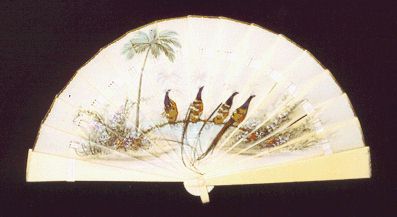
Zelluloid-Fächer
mit 4 Pfauen und Palme. Die Pfaue haben kleine Pfauenfedern appliziert.
Österreich,
ca. 1905
Celluloid-fan with 4 peacocks and a palmtree. The peacocks have
small peacock-feathers applied to them. Austria, approx. 1905
Die
in der 2. Hälfte des 19. Jahrhunderts bis Anfang des 20. Jahrhunderts
durchgeführten Weltausstellungen - pompöse Schau-Feste, die
Neuigkeiten der Technik und Industrie mit Pavillons exotischer Länder
vermischten - waren am Ursprung des Interesses für die Kunst und
Kultur ferner Länder. Schon immer hat das Neue, Unbekannte gereizt
und fand seinen Einzug in Mode - und darin auch Fächer. Beispiele
gibt es genug: Die Erfindung des "Cabriolets" im 18. Jahrhundert
und die darauffolgenden Fächer, die die druchbrochenen Radspeichen
nachahmten; die Ballonaufstiege in Frankreich und England; die erste
Giraffe in Paris.
Gegen Ende des 19. Jahrhunderts, mit der Aufbruchstimmung, das Jahrhundert-Wenden
mit sich bringen, fiel der orientalische Einfluss auf fruchtbaren Boden.
P. Plener beschreibt in seinem Essay "Sehnsüchte einer Weltausstellung
- Wien 1873", 2001 geschrieben: "...durch die Realität
der Zeit wurden Erotik und Exotik [...] beinahe Synonima". Diese
Assoziation ist sicher mit ein Grund für den anhaltenden Erfolg
exotischer Motive.
In
the second half of the 19 c. to the beginning of the 20 c., World Exhibitions
nurtured the interest in arts and culture of far-away countries, in
particular the East. These exhibitions were sumptuous festivities, showing-off
newest technical and industrial achievements and mixing them with exotic
countries' products.
The new and unknown was always attractive. It influenced daily life
like fashion and did not stop at fans. Well-known examples are the "cabriolet"-
fans, imitating the spoke-wheel of the latest 18 c. craze; the balloon
ascents; and the first giraffa in Paris.
Towards the end of the 19 c., in the wake of the turn of the century, exotic features found an extremely fertile ground not least because of the association of exotic and erotic, as quoted by P.Plener, Vienna 2001.